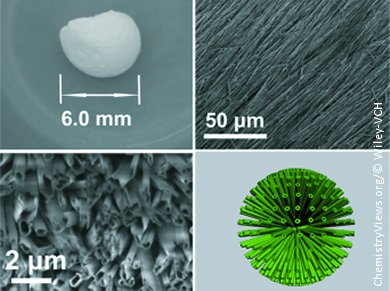Rebuilding Damaged Teeth and Bone
A novel biomimetic approach to synthesizing crystallites of hydroxyapatite, the mineral found in the body’s hard tissues, could give dentists and surgeons the ability to rebuild damaged teeth and bone, thanks to research being carried out in China.
Tooth enamel consists of highly organized arrays of hydroxyapatite (HAP) crystallites. The mineral is a form of calcium phosphate and well known to science as the inorganic component of vertebrate bone and teeth. The development of highly ordered arrays of this mineral has been used widely in studies to help researchers learn about how hard tissues grow. The obvious extension of such work being the potential to remediate issues such as damaged or decayed bones and teeth. Moreover, it could perhaps be to find ways to ameliorate or even reverse one of the most debilitating diseases, osteoporosis.
A Solvothermal Approach
A team led by Ying-Jie Zhu, Shanghai Institute of Ceramics, Chinese Academy of Sciences, China, has turned to a solvothermal approach to the synthesis of hydroxyapatite crystallites starting from a calcium oleate precursor. In this process, calcium chloride, oleic acid, and sodium hydroxide were reacted together in deionized water and ethanol solution at room temperature. The resulting powdered precursor was then pressed into a disk at 8·106 Pa and heated at 180 °C with sodium dihydrogen phosphate again in ethanol and water.
This solvothermal process allowed the team to build millimeter-scale three-dimensional and highly ordered arrays of hydroxyapatite microtubes. A longer reaction time produces bigger units; 48 hours gave the biggest products investigated in this study. The team describes the microtubes as “ultralong” and explains that they form the shell of an oblate sphere structure with a core composed of unordered hydroxyapatite nanorods, and highly ordered hydroxyapatite microtube arrays as the shell around the core that have a diameter of 6 mm and are up to 1.4 mm thick.
Highly Ordered Hydroxyapatite Microtube Structures
These materials could have wide biomedical applications the team suggests, such as recreating dental enamel. This is especially so given that hydroxyapatite, Ca10(OH)2(PO4)6, is highly biocompatible and essentially nontoxic. Moreover, while bone and tooth growth, if it were possible to trigger it, is very slow, the solvothermal production process is relatively rapid. Its biocompatibility lends itself to acceptance by the body when used in implants and prostheses where soft tissues can connect and interleave with the material at the biomolecular level. This is in stark contrast to the inability of soft tissues to grow in and around metal and entirely synthetic ceramic implants and prostheses to a useful degree, an issue that can give rise to rejection of an implant.
The team points out that templating based methods have previously been used in an effort to grow nanostructured hydroxyapatite. However, the size of the ordered hydroxyapatite structures are usually only several micrometers. Highly ordered hydroxyapatite structures with sizes larger than 100 mm are very difficult to prepare. These results have been disheartening for those searching for a way to mass produce the bio-mineral for repairing teeth and bones with large ordered structures. Products on the millimeter scale are much more substantial, obviously.
Zhu and colleagues, having produced such products comprising highly ordered hydroxyapatite microtube structures, also point out that the nature of their materials might also allow the microtubes to host guest molecules. These could be pharmaceutical agents such as antibiotics and growth promoters to preclude bacterial infection and allow faster soft tissue ingress.
“This is an interesting study,” says William Murphy, who is Harvey D. Spangler Professor of Biomedical Engineering and Orthopedics and Co-Director of the Stem Cell and Regenerative Medicine Center, University of Wisconsin, Madison. “The long-range ordering of the hydroxyapatite materials is intriguing, and bears some geometric similarities to biological materials such as enamel,” he adds. “Natural minerals are typically formed with significant contribution from organic components, resulting in an organic-inorganic composite. The material in this study is intriguing as it achieves ordering without organic templating.”
- Solvothermal Transformation of Calcium Oleate Precursor into Large-Sized Highly Ordered Arrays of Ultralong Hydroxyapatite Microtubes,
Bing-Qiang Lu, Ying-Jie Zhu, Feng Chen, Chao Qi, Xin-Yu Zhao, Jing Zhao,
Chem. Eur. J. 2014,
DOI: 10.1002/chem.201400252




